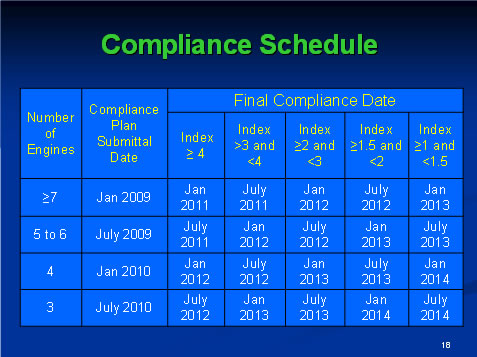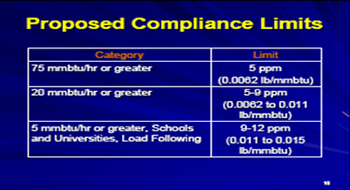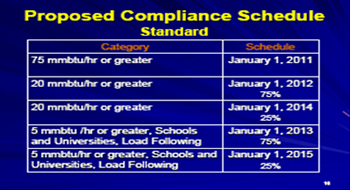
RULE 1171 UPDATE
Rule 1171 regulates VOC-containing materials during the clean up of lithographic presses using conventional inks, Ultraviolet/Electron Beam (UV/EB) inks, and screen printing equipment, as well as all solvents suppliers who supply solvent cleaning materials used in solvent cleaning operations. Based on requests from the printing industry, SCAQMD staff has agreed to delay by one year the compliance date for the use of 100 gram per liter clean-up solvents in lithographic UV/EB ink application equipment including cleaning of metering rollers, dampening rollers and printing plates in UV/EB ink application equipment. The new compliance date is January 1, 2009. Until then, the VOC limit for hand-wipe and automatic UV/EB operations (cleaners for rollers, blankets, metering rollers, dampening rollers and printing plates) is 650 grams per liter. As of January 1, 2008, the limit for cleanup of conventional ink systems (roller wash, blanket wash, metering rollers, dampening rollers and printing plates) is 100 grams per liter.
Staff’s proposal also includes a limited exemption for on-press cleaning of screens in screen printing equipment. Staff is seeking comments on an industry proposal to extend the exemption for cleaning of UV/EB lamps and reflectors.
Proposed Amended Rule 1171 will expand the rule’s applicability to include all suppliers of solvents for use in solvent cleaning operations subject to this rule. Staff’s proposal will add provisions to require such suppliers to maintain records and to provide dilution instructions. Staff’s proposal will also subject solvent suppliers to liability for assisting in the non-compliant use of cleaning solvents.
SCAQMD PROPOSES NEW RULE FOR MULTIPLE DIESELENGINE FACILITIES (RULE 1472)
The South Coast Air Quality Management District (SCAQMD) recently held a public workshop announcing their proposed new Rule 1472—Requirements for Facilities with Multiple Stationary Emergency Standby Diesel-Fueled Internal Combustion Engines. Rule 1472 is a new rule which seeks to regulate diesel particulate emissions at facilities with multiple emergency diesel engines. Diesel particulate emissions were declared as toxic by the state back in 1998. The district estimates that there are approximately 550 facilities that will be impacted by the proposal.
The SCAQMD proposal will add the contaminant to the list of toxic air contaminants subject to regulation under Rules 1401 and 1402. Rule 1401 applies to new, modified, or relocated permit units. It establishes risk-based thresholds for cancer and non-cancer toxic air contaminants (TACs). As a result, emissions from Rule 1472 engines would be evaluated for compliance with Rule 1401. Rule 1402 applies to facility-wide TAC emissions and sets risk-based thresholds for cancer and non-cancer impacts for purposes of notification and risk reductions. It implements the AB2588 Air Toxics Hot Spots program. Compliance with proposed Rule 1472 will typically satisfy Rule 1402 risk reduction requirements. Facilities that exceed the “significance” level of 100 in one million must comply with Rule 1402. Likewise, facilities with non-emergency diesel engines are subject to Rule 1402 requirements.
Proposed Rule 1472 would apply to engine groups of three or more engines (rated at 50 bhp or greater) within 150 meters of one another and having an Engine Group Index greater than 1.0 (one). Facilities with three or more engines within 150 meters of one another must file compliance plans. Compliance plans are to include engine information, locations, identification of engine groups and the Engine Group Index for each engine group. The Engine Group Index is defined as the sum of indices for each engine in the group at the facility for the nearest residential/sensitive receptor.
Engine Group Index = Si (EFi x Operating Hoursi x Distance Factori)
Where:
EF = PM emission factor for the engine (grams/bhp-hour)
Operating Hours = Rule 1470 allowable or maximum permitted annual operating hours for testing and maintenance (hours), whichever is less
Distance Factor = Factor from Table 1 of the rule corresponding to the engine rating (bhp) and distance to the nearest receptor. Distance to the nearest receptor is measured from the exhaust stack of the engine to the nearest receptor location. When the engine rating is not listed on the tables, the closest engine size shall be used.
Facilities are to notify SCAQMD whenever engines are added or removed.
Facilities where an Engine Group Index exceeds 1.0 will need to:
- Reduce the Engine Group Index to less than or equal to 1.0; or
- Emit diesel PM at a rate less than or equal to 0.15 g/bhp-hr for each engine; or
- Emit diesel PM at a weighted average rate of less than or equal to 0.15 g/bhp-hr for all applicable engines within an engine group calculated by the following formula:
| Weighted Average = | Si (Ratingi x Operating Hoursi x Emission Ratei) |
| Si (Ratingi x Operating Hoursi) |
Where:
Weighted Average = The weighted average for diesel PM emission rates
(g/bhp-hr)
Rating = Engine rating (bhp)
Operating Hours = Maximum permitted annual operating hours for testing and maintenance (hours)
Emission Rate = Diesel PM emission rate (g/bhp-hr)
Facilities are allowed the flexibility to choose one of the compliance options and determine how to meet the emission requirements. Table 1 shows the compliance schedule facilities are subject to under Rule 1472.
Table 1 – Rule 1472 timelines

The following are exempt from the requirements of Rule 1472:
- Facilities which comply with all applicable requirements of Rule 1402.
- Facilities which can demonstrate that each emergency standby diesel-fueled engine at the facility is greater than 150 meters from the nearest receptor.
- Direct-drive emergency standby fire pump engines fueled by diesel. A direct-drive emergency standby fire pump engine is an engine directly coupled to a pump exclusively used in a water-based fire protection system.
- Subdivision (f) of the rule will not apply to facilities with an exemption approved by the Executive Officer.
Facilities which are unable to meet the emission levels required by the rule due to some extreme circumstance must include, as part of their compliance plan, a request for exemption and details of why they will not be able to comply. The rule is scheduled for final adoption in February 2008.
BOILERS, STEAM GENERATORS AND HEATERS IMPACTED BY CHANGES TO RULE 1146
SCAQMD Rule 1146 addresses emissions of oxides of nitrogen from industrial, institutional and commercial boilers, steam generators and process heaters with maximum rated heat input capacities greater than or equal to 5 million BTU/HR. The amended rule will apply to facilities with multiple units totaling in a heat input greater than 8 million BTU/HR, even though individual unit’s ratings might be less than 5 million BTU/HR. This rule does not apply to electric utility boilers, refinery boilers and process heaters with a rated heat input greater than 40 million BTU/HR, sulfur plant reaction boilers, or waste heat recovery boilers serving combustion turbines. The AQMD recently held a public workshop to announce proposed reductions of NOx emissions. If the proposed amendments are adopted, NOx limits will drop from the currently allowable (except for low fuel burning equipment) 30 parts per million (ppm) to 12 ppm, 9 ppm or 5 ppm, depending on equipment size and operational characteristics, as well as recognizing energy efficiency. The proposed compliance limits for units burning landfill or digester gas are 25 ppm and 15 ppm, respectively.
The current CO limit for all Rule 1146 equipment is 400 ppm;
Other proposed changes include requiring annual tune-up procedures and monthly maintenance procedures, limiting time to de-rate equipment and applying a 30 ppm limit to low fuel usage equipment at burner replacements but no later than a 15 year equipment life.
The compliance schedule is staged over a six-year period, taking into consideration size range and unit operation. Facilities with multiple units are offered an option for a later compliance date at a more stringent limit. Units with low fuel usage (less than 90,000 Therms per year) can take advantage of an exemption in the rule.
The following tables outline the proposed compliance limits & schedules:
 |  |
The AQMD is soliciting comments and many changes might still be made to the proposed rule prior to adoption, which is scheduled for Spring 2008.
CALIFORNIA AIR RESOURCES BOARD ADOPTS GLOBAL WARMING REDUCTION MEASURES
The California Air Resources Board (ARB) unanimously approved a greenhouse gas emission limit for the year 2020 and adopted regulations to require large facilities to report greenhouse gas emissions. The actions are part of the AB32 (The Global Warming Solutions Act of 2006) legislation which requires greenhouse gas emission reductions down to 1990 levels by the year 2020. The quantification of the 1990 levels has been at issue with some industry representatives still disagreeing with the ARB staff calculations. The ARB estimates that the 1990 levels amounted to 427 million metric tons of carbon dioxide equivalent statewide. The figure is based on a variety of data sources including fuel combustion, industrial processes and agricultural practices. ARB staff calculated the total emissions of six greenhouse gases (carbon dioxide, methane, nitrous oxide and three gases used in industrial applications). Carbon dioxide emissions comprised 89% of the total. Each greenhouse gas has a different global warming potential (i.e. one ton of methane has 21 times the global warming potential as a ton of carbon dioxide). A carbon dioxide “equivalent” was arrived at for each substance taking the global warming potential into consideration.
The ARB project that, if no action were taken, emissions would rise to 600 million metric tons in a period of 13 years. In order to comply with the 1990 levels emissions requirements, the state will have to reduce emissions by 173 million tons of carbon dioxide equivalent by 2020 in order to meet targets. Under the new measure, sources emitting over 25,000 metric tons of carbon dioxide and other gases per year will have to report their greenhouse gas emissions. It is expected that over 800 of the largest emitters in the state will be impacted. The facilities contribute approximately 94% of the emissions and include electric generators, oil refiners, cement plants and industrial stationary combustion sources (such as large furnaces). The universe of combustion sources is made up of food processing, glass container manufacturing, oil and gas processing, and mineral processing facilities. Back-up generators, schools and hospitals are exempt from the requirements. Impacted facilities will have to begin tracking the emissions in 2008, to be reported to the ARB by the beginning of 2009.
The ARB announced plans to outreach to local government (cities and counties) in an effort to get them to voluntarily reduce greenhouse gas emissions. Thus far, over 100 cities have made commitments to reduce global warming contaminants. Also, the agency plans to explore state regulation of land use which has been typically under the jurisdiction of local government bodies.
